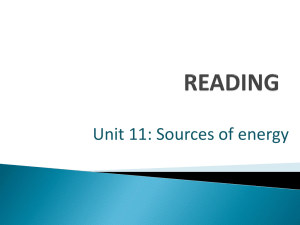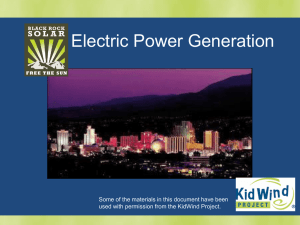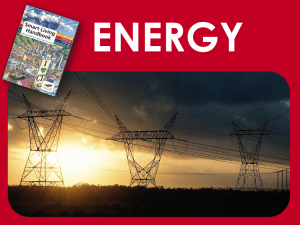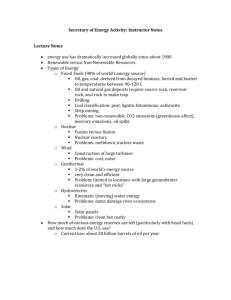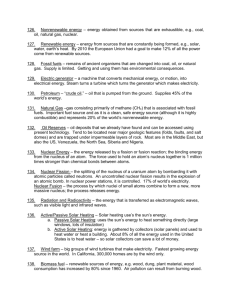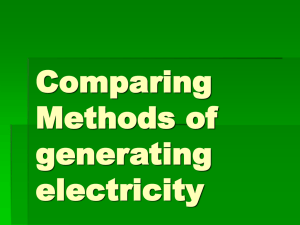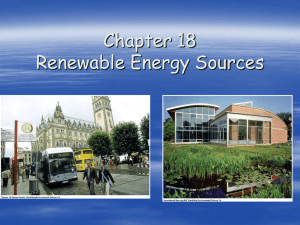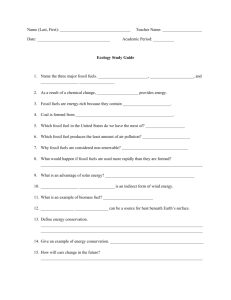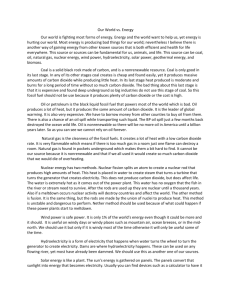Outline Notes - Toms River Regional Schools
advertisement
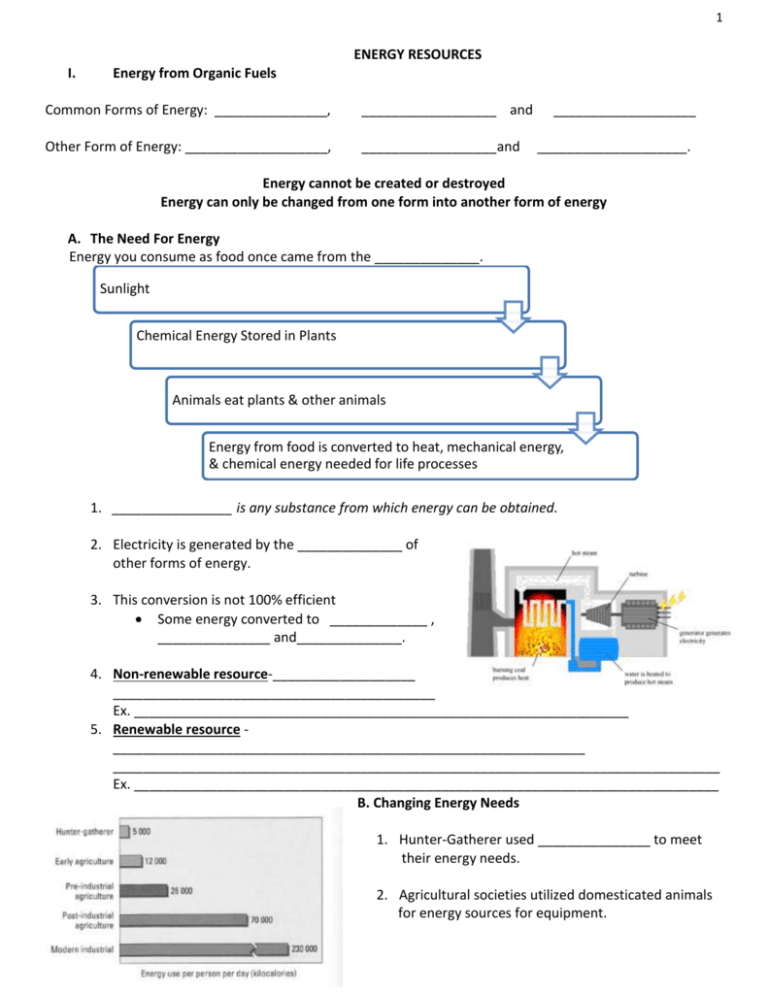
1 ENERGY RESOURCES I. Energy from Organic Fuels Common Forms of Energy: _______________, __________________ and Other Form of Energy: ___________________, __________________ and ___________________ ____________________. Energy cannot be created or destroyed Energy can only be changed from one form into another form of energy A. The Need For Energy Energy you consume as food once came from the ______________. Sunlight Chemical Energy Stored in Plants Animals eat plants & other animals Energy from food is converted to heat, mechanical energy, & chemical energy needed for life processes 1. ________________ is any substance from which energy can be obtained. 2. Electricity is generated by the ______________ of other forms of energy. 3. This conversion is not 100% efficient Some energy converted to _____________ , _______________ and______________. 4. Non-renewable resource-___________________ ___________________________________________ Ex. __________________________________________________________________ 5. Renewable resource _______________________________________________________________ _________________________________________________________________________________ Ex. ______________________________________________________________________________ B. Changing Energy Needs 1. Hunter-Gatherer used _______________ to meet their energy needs. 2. Agricultural societies utilized domesticated animals for energy sources for equipment. 2 3. Industrial societies increased energy consumption due to use of _________________________. C. Organic Fuels 1. Organic fuels: _____________________ ______________________________________________ _________________________ 2. A compound composed only of carbon and hydrogen is called a _____________. Draw molecules below CH4 = Methane C2H6 = Ethane C8H18 = Octane 3. Hydrogen may contain impurities Other chemicals such as ______________ and __________ compounds Impurities contribute to the __________________ 4. Fossil Fuels - Stored energy from ancient organism can be used today as a fuel source. Examples of fossil fuels: ___________, ________________, and ___________________________. D. COAL plants + swamps + sediment + time = Coal Formed when ancient plant material is compressed below sediment _______________that is an organic fossil fuel Heat and pressure Forces out _______________ Increases the ___________________ concentration ____________ carbon concentration means _________energy and less smoke released during combustion. 1. Stages in Coal formation a. _______________ b. ________________ 3 c. ________________________________ d. _____________________ a. Peat It is found on the Earth’s surface Compressed ____________ material ______________ water concentration Low ____________ concentration Burns ________________ Brittle & Brown Low ______________ Resembles decaying wood b. Lignite Compressed ______________ Lower ____________ concentration Soft, brown coal composed of about _____________ carbon Releases little smoke& burns quickly Found below surface and must be _____________ c. Sub-Bituminous coal Type of coal whose properties range from those of ________________ to those of __________________________________ Used primarily as a fuel for ___________________________________________ d. Bituminous coal Soft black coal Most abundant type of coal in __________ It forms deep in Earth's crust Less water and fewer impurities than lignite Higher _____________ content (85%) Releases little smoke and burns _____________ than lignite Widely used industries– power plants e. Anthracite __________________________________________ Shiny black color Least water, fewest impurities Highest carbon content (_____%) Located ______________ in the ground than any of the other forms of coal. Burns the hottest with the least amount of ___________ and is the most valuable Most expensive 4 Homework 1. Compounds that contain only carbon and hydrogen are (a) fuels; (b) fossil fuels; (c) organic fuels; (d) hydrocarbons. 2. Energy conversion is not 100% efficient because energy is lost in the form of (a) light (b) heat (c) sound (d) all of the above 3. The type of society that has the greatest energy needs is the (a) hunting society; (b) gathering society; (c) industrial society; (d) agricultural society. 4. The first stage in the formation of coal is (a) lignite; (b) peat; (c) anthracite; (d) bituminous coal. 5. The type of coal that has the highest carbon content is (a) peat; (b) lignite; (c) bituminous coal; (d) anthracite. 6. The most abundant form of coal in the United States is (a) peat; (b) lignite; (c) anthracite; (d) bituminous coal. 5 E. PETROLEUM AND NATURAL GAS Coal is in the ____________________ phase Petroleum is in the __________________ phase Natural gas is in the __________________ phase 1. Petroleum organic material + shallow seas + sediment + time = Petroleum Syrupy black liquid fossil fuel Formed from the remains of ______________________________and other microscopic _____________, plants, and animals living in shallow seas millions of years ago Draw an oil trap below: Impermeable:_____________________________________________________ Permeable : ______________________________________________________ a. Petroleum is separated or refined to make a variety of products. List some here: b. Worldwide population increases, so does the _____________ for petroleum. 2. Natural Gas a. Mixture: ____________ major hydrocarbon Ethane and propane may be present as minor hydrocarbons Trace amounts : Hydrogen sulfide Carbon dioxide Nitrogen Helium b. Use: Industry Homes & businesses for _____________________________________ _________________________________ Household appliances Does not have to be converted to electricity first; _______________________ c. Natural gas forms in much the same way as petroleum Often found trapped above _________________ pools 6 Sometimes viewed as waste of __________________ F. Problems with Fossil Fuels 1. _________________ and _________________ 2. Oil spills and other forms of widespread _________________________________________ are possible results of exploring for fossil fuels. An alternative to seeking new fossil fuel sources is to depend on the large deposits of oil that are already known to exist. Unfortunately for many nations, oil deposits are not always located in the same country that needs the fuel. In I991, Operation Desert Storm, reminded many Americans of the need to reduce their dependence on imported oil. 3. Pollution of various kinds, especially _________________, is produced by the use of fossil fuels. a. Burning releases ______________________ 4. Increased use of fossil fuels since the Industrial Revolution caused the amount of carbon dioxide in the atmosphere to increase by more than ____%. 5. Many scientists, as well as other citizens, think that this increase in carbon dioxide could raise the temperature of Earth through a process called the _________________effect. 6. Natural gas is extremely _________________ 7. Coal miner hazards: suffocation by natural gas, _________________ of natural gas and coal dust G. Biomass Fuels 1. A fuel formed from the products of living organisms. 2. Ex.____________, _____________, ______________, and _________________ 3. Biomass fuels are a _________________resource and can be produced in large quantities specifically for use as fuels. 4. Wood a. Cheap, used greatly in developing nations 1. People spend a great deal of time searching for the wood necessary to meet their energy needs. b. Wood gives off a great deal of smoke that is high in _________________. c. Obtaining wood can be damaging to _________________. 5. Garbage a. Garbage produced in homes is composed largely of _________________materials, such as paper and food scraps 7 b. About 2/3 of the material in garbage can be burned c. Heat produced from burning garbage is used to change water into steam d. The steam turns the _________________ that generate electricity. 6. Methane a. Swamp gas is a naturally produced form of _________________ b. Decaying _____________________ in dumps also produces methane c. Today, methane is being removed from swamps and garbage dumps for use as a fuel. 7. Alcohol a. _____________________________ - the conversion of organic materials into fuels i. Ex. Use of plants (corn & sugarcane) to make ____________________ b. _________________ - made by yeast through the process of _________________ i. A liquid biomass fuel that burns __________________ and is a renewable resource. ii. Gasohol - mixture of _________________ gasoline to _________________ ethanol. Homework 1. Coal: fossil fuel as (a) petroleum: crude oil; (b) peat: coal; 2. Crude oil is another name for (a) alcohol; (b) methane; (c) methane: swamp gas; (c) peat; 3. Petroleum: plastics as (a) alcohol: gasoline; (b) coal: carbon; 4. Mines: coal as (a) petroleum: refineries; (b) corn: alcohol; (d) alcohol: biomass fuel. (d) petroleum. (c) garbage: electricity; (c) land: agriculture; 5. The use of corn to make alcohol is an example of (a) bioconversion; (b) fossil fuels; (c) hydrocarbon; (d) industry: fuels. (d) wells: petroleum. (d) refining. 6. Of the following the only example of a biomass fuel is (a) coal; (b) petroleum; (c) wood; (d) natural gas. 7. The process by which alcohol is made by yeast is called (a) fermentation; (b) bioconversion; (c) purification; 8. Unlike fossil fuels, biomass fuels (a) do not release carbon dioxide; (b) are renewable resources; (c) are buried beneath the surface; (d) distillation. 8 (d) are not products of living things. II. ATOMS AND RADIOACTIVITY A. Atoms:___________________________________________ Composed of: 1. ________________ _______________ 2. ________________ 3. ________________ _______________ Atom # of p+ = # of –e B. Atoms and Isotopes 1. AII atoms of the same element have the same number of ____________in their nuclei. a. Atomic # = ___________________________________________________ Ex. oxygen has 8 ____________, and its atomic number is 8. b. Atomic Mass/ Mass # - ______________________________________________________ c. Individual atoms of the same element may have different mass numbers because the number of ____________ in the nucleus can vary. For example, all atoms of the element oxygen have 8 protons. Most atoms of oxygen have 8 neutrons and a mass number of 16. However, some oxygen atoms may have 9 or 10 neutrons. d. Isotopes - Atoms of the same element that have different numbers of ___________________ Ex. Uranium has 92 protons, and most uranium atoms contain 146 neutrons and have a mass number of 238. This form of uranium is commonly called U-238. Another isotope of uranium, called U-235, has only 143 neutrons and has a mass number of 235. Change in Number of Electrons Change in the Number of Neutrons - - - - - - 9 C. Radioactivity 1. _______________________ - unstable isotopes of atoms, emitting particles and energy from their nuclei as they decay 2. The three types of radiation emitted from radioactive atom: a. ________________________________________________________________________ b. ________________________________________________________________________ c. ________________________________________________________________________ 3. __________________________-The amount of time it takes for half of the atom in a sample of a radioactive element to decay is the D. REACTIONS AND REACTORS 1. Energy holds the nucleus of atoms together 2. _____________________________- splitting the atom; releases energy a. Can be used to generate electricity. b. Uranium-235 is the atom used most commonly in fission reactions c. An atom of U-235 is fissionable i. ____________ when its nucleus is struck by a ____________. ii. When U-235 splits, it releases energy and forms new nuclei, called ____________ nuclei. The steps in the fission of a U235 atom are shown in the diagram. To begin the reaction, a neutron is fired into the nucleus of the atom. The neutron strikes the nucleus, which splits, forming two daughter nuclei. The reaction also releases energy and several more neutrons. These neutrons can strike other U235 nuclei, causing those nuclei to split and release more energy and more neutrons. This continuous action of neutrons splitting atomic nuclei is called a chain reaction. E. Nuclear Reactors 1. Nuclear reactors function very similarly to fossil fuel power plants. 2.____________ is released from the nuclear reaction __________ ___________turns turbines electricity is _______________ boils water steam rises 10 3. Water performs two functions: a. Acts as a coolant, absorbing heat and keeps the core from ____________. b. Slows the movement of the neutrons released during the chain reaction to allow for the chain reaction to _______________________ c. Control ____________ regulate speed of the chain reaction i. Made of cadmium, boron, or other materials that absorb neutrons Homework 1. Protons and neutrons are found together in the part of the atom called the (a) alpha particle; (b) electron; (c) nucleus; (d) isotope. 2. Two atoms of the same element with different mass numbers are called (a) isotopes; (b) nuclei; (c) electrons; (d) neutrons. 3. One kind of radiation not released by radioactive decay is (a) alpha particles; (b) free protons; (c) beta particles; (d) gamma rays. 4. All isotopes of an element contain the same number of neutrons. TRUE or FALSE 5. Beta particles contain two protons and two neutrons. TRUE or FALSE 6. The fuel most commonly used in fission reactions is (a) Np-239; (b) U-238; (c) U-235; (d) Pu-239. 7. Devices that absorb neutrons and are used to control the speed of a fission reactor are called (a) reactor vessels; (b) fuel rods; (c) containment buildings; (d) control rods. 9. A fission chain reaction begins when an atom of U-235 is struck by a neutron. TRUE or FALSE 10. In a fission reaction, some of the mass of the original atom is converted to energy. TRUE or FALSE F. RADIOACTIVE WASTE 1. Produced by Nuclear power plants About _____ metric tons of spent fuel is produced by a typical nuclear reactor each year. 2. Nuclear plants produce large quantities of ______-________ nuclear wastes during the course of normal operation. Cells that are actively dividing, such as skin cells and the blood-cell producing cells in bone marrow, are especially sensitive to radiation. The amount of exposure determines the extent of damage. Large doses of radiation can cause severe, 11 immediate effects, including skin burns and anemia, even death. Radiation also causes changes in DNA, leading to long-term effects such as cancer and genetic mutation. 4. Radiation exposure is measured in ______________. 5. Most Americans receive between ______-_____ rems per year from background radiation. G. Types of Waste 1. __________________________ - Radioactive wastes that emit large amounts of radiation Ex. 1. _________________________________ 2__________________________________ 3. ______________used to cool and control the chain reactions a. These wastes are very dangerous to handle and may also be ____________ b. May be ______________________ for tens of thousands of years 2. Medium-level and low-level wastes a. Not as radioactive as high-level wastes b. Much ___________ volume is generated (more common) c. Can be dangerous for 300 years or more d. Ex. i. _____________________ ii. Contaminated protective clothes of a power plant worker e. Produced by hospitals and laboratories H. Waste Disposal 1. The contaminants may have long half-lives, taking _______________of years to decay Plutonium-239, for example, is a high-level waste product of nuclear reactors. Pu-239 has a half-life of 24,000 years. Plutonium waste will remain dangerous for 192,000 years. Plutonium is also a deadly poison, even in small amounts. 2. The long half-lives of elements in radioactive wastes pose a serious ______________ problem. 3. Wastes must be sealed in containers that will not corrode for thousands of years. 4. The U.S. government has decided to seal the wastes in thick blocks of __________. a. Sites must be __________________________ b. Earthquake or ________________________ could spill the stored wastes c. Must be stored deep _____________________________ , which is costly Almost all the high-level radioactive wastes in the world have not been disposed of permanently. They sit in storage tanks outside nuclear power and nuclear plants. In many cases, these tanks have begun to 12 leak, contaminating the groundwater and releasing radioactive wastes into the environment. These wastes must be permanently removed before the contamination gets worse. The government predicts that the cleanup of 20 of the most contaminated nuclear weapons sites in the United States could cost $600 billion! 5. Medium-level and low-level wastes also pose disposal problems 6. Low-level wastes are often buried or enclosed in _______________and dropped into the __________ These methods of disposal expose the environment to contamination. Most medium- level wastes have not been disposed of permanently. A permanent disposal site for medium-level wastes presents many of the same problems as does a site for high-level wastes. I. Safety and Cost If the _______________ and control systems in a reactor core fail, the chain reaction can no longer be _______________. The core will grow hotter, causing the fuel rods and even the reactor vessel to melt – Meltdown. A full ______________ would release huge amounts of radiation into the environment. In April I986, however, one core of the _______________ nuclear power plant in Ukraine did melt down. The plant's control rods were made of graphite. The graphite began to burn, and fire spread radioactivity over a vast area. More than ___ people were killed immediately, and _______________ people had to permanently leave their homes. Scientists think that Chernobyl radiation may eventually cause as many as __________cases of cancer. The __________plant was old and lacked many of the safety features built into newer plants. The accident was caused by __________error. The severity of this accident and the problems with radioactive waste disposal has led many people to question the wisdom of using nuclear power. Nuclear power plants are also very expensive because the required __________ measures are very costly. Homework 1. Each year, an average person in the United States is exposed to a radiation level of (a) 2 rems; (b) 0.2 rems; (c) 20 rems; (d) 200 rems. 2. Pu-239 has a half-life of (a) 24 years; (b) 240 years; (c) 2400 years; (d) 24 000 years. 3. Losing control of the fission reaction in a reactor core may result in a (a) cooldown; (b) meltdown; (c) draindown; (d) cooling tower. 4. The number of people forced to evacuate because of the Chernobyl accident was (a) 1,160; (b) 11,600; (c) 116,000; (d) 1,160,000. 5. Radon gas is responsible for 25 percent of the radiation in most U.S. homes. TRUE or FALSE 6. Plutonium must be stored for 192,000 years before it is safe. TRUE or FALSE 13 7. The cleanup of the 20 most polluted nuclear weapons facilities in the United States will cost $600 billion. TRUE or FALSE 14 Yucca Mountain Almost one-fifth of the world depends on nuclear power for electricity. But nuclear power also generates radioactive wastes. For many years, nuclear power plants have stored their own __________, but storage space is running out. Several ideas for long-term storage of radioactive waste have proposed. One idea is to build a __________repository where be buried several hundred meters deep in solid __________or salt beds. been waste can In 1987, the U.S. Congress selected Yucca Mountain in the desert as a possible geologic repository. If the project is is estimated to cost between ______________ billion and fully operational by 2010. The proposal of using Yucca however, has raised many questions. Nevada approved, it could be Mountain, Should Yucca Mountain he used for a nuclear-waste repository? Use Yucca Mountain as a Repository Geological evidence indicates that the Yucca Mountain area has changed little over the last million years. Scientists predict it will remain undisturbed for up to __________years after the repository is sealed. The repository will be __________ deep, within hard rock deposits. At this depth, it is still __________ above the water table. Little groundwater flows through Yucca Mountain, so the waste canisters will stay dry and remain intact. Don’t Use Yucca Mountain as a Repository Scientists cannot predict every problem that might arise in the repository. Heavy __________ or seismic movements could raise the water table, causing canisters to corrode and leak waste into the _______________ . Once in the groundwater, the waste could reach the area's water supply, causing serious illness to people who drink the water. Some of these chemicals remain radioactive for thousands of years. Scientists do not know for certain how long waste can remain buried without affecting the surrounding area. Consider the Issue 1. Should Yucca Mountain be used to store radioactive wastes? Explain your answer. 2. Would you want to live in the area around Yucca Mountain? Why or why not? 15 III. SOLAR ENEREY A. Energy from the _____________, or solar energy, Absorbed by ________________ Used as fuel by virtually all organisms. Transferred into _________________________ Drive ________________________ o _________________________________________ B. Uneven warming of Earth Cause winds to __________ Wind energy C. Thermonuclear Fusion High temperatures cause hydrogen nuclei to fuse forming _______________ nuclei Loss of ____________ occurs – energy production ______________________________________ D. Sun as Fuel: Generate heat and electricity Free, clean and ______________ 1. Solar energy Drawbacks Equipment expensive Not constant - limited sunlight ______________________ _____________ Size and cost of the equipment may outweigh the benefits Technology progresses o More ________________________________ 2. Passive Solar Energy Used directly Light or heat Collected, stored, and distributed naturally in an enclosed dwelling Not used to _____________________________________ Ex. ____________________________________ South-facing windows can gather the greatest amount of the sun's energy for the longest number of daylight hours. In addition, these homes contain building materials and furnishings that best absorb solar energy. Examples of such materials are stone, brick, and concrete. Notice the large, dark, water-filled barrel in the glass enclosure; barrels are used as energy-absorbing and storage structures. The barrel absorbs energy during the _____ and releases energy at ________. There is the large overhang to prevent exposure to summer sun. 16 3. Active Solar Energy Active solar heating devices are used to: o collect, store, and circulate heat o Produced from _____________________ greater capacity than a ______________________ uses tubes, tanks, fluids, fans, pumps, etc. Ex. Used in Israel, India, Japan, & West Indies to ______________________________________ Can be used to produce ____________ to turn a _____________ to generate electricity a. Solar Collectors: mounted on roofs o _______________________ o saves space on ground b. Flat-plate collectors A large, flat box Base made of a _______________________ covering a layer of insulation. Fluid-filled tubes run across top of metal Usually ___________, or antifreeze Temperatures rise up to _____________ Circulates like a _____________________ c. Mojave Desert – ___________________ 1800 giant mirrors to concentrate the sun's rays at one position Heat to produce steam. Steam turns turbines Produces _______________ for 10,000 people. d. Photovoltaic Cells (PV cells) – Solar cells Produce electricity directly Two thin semiconductor materials joined together. o ___________ or selenium Sunlight causes ____________ to move Ex. Solar Powered Calculator IV Electricity Static Electricity Direct Current (DC) Alternating Current (AC) A. Static Electricity Involves electrons that are ___________________________________________________ – Usually by ______________________________________ on a __________________ 17 – Objects may be attracted to each other like ___________________________________ – Or ______________ may occur like a shock or __________________ B. DC - Direct Current Current that __________________________ through a conductor, such as a _____________________________. Usually get ____________________________________________ Produced by ___________________________________________ C. AC – Alternating Current A ____________________________ movement of _________________ in a _________, similar to sloshing _______________back-and-forth in a _____________. Many electrical devices like _______________________ only require that the __________________________________________ More ____________________________________________________ way of providing ________________________ power. V. Photovoltaic Cells A. Photo = _________________ B. Voltaic = ________________ Photovoltaic cells _________________________________________________________. VI. Photo Voltaic Cells (Solar Cells) Si Low _____________________________________ color used Square cells are made out of ____________________ Each square is cut from an ____________________________________ so there is no waste 18 A. Silicon Wafers A Silicon atom will always look for ways to fill up its last shell (which would like to have _________________________________). Si Si A wafer of _____________________________ is a ______________________________ because ______________________________________ are free to flow & make a current __________________________ is sprayed on one wafer Silicon has _______________________ in its outer shell while _____________________ ________________________________ = ____ electrons for outer shell o Extra Electron causes the wafer to have a __________________________________ = _______________________________ ________________________ is within the wafer Silicon has ___________________________ in its outer shell while _________________ B Si __________________________ = __ electrons for outer shell o Missing Electron causes the wafer to have a __________________________________ = __________________________ VII. Our Sun Can Generate Electricity _____________________ - visible-light particle Photons from sunlight __________________________________________ causing a _____________________________________ between the _______________________ 19 & the ________________________________ This creates a flow of charge through ________________________________ VIII. Solar cells are useful because they: are _____________________ have ________________________________________ cause _______________________________________ in operation (recyclable when old) _______________________________________________ work in __________________________________ and are more __________________ in _______________________________________________ are not unattractive can generate power ________________________________________________________, without the need for electricity pylons and wires. Homework 1. Of the following, the energy source that can be used in the greatest number of areas is (a) geothermal energy; (b) wind energy; (c) hydroelectric power; (d) solar energy. 2. How does active solar energy differ from passive solar energy? 3. How can solar-powered automobiles help reduce pollution? 4. Photovoltaic cells convert the energy of the sun to 20 (a) heat (b) light (c) electricity; (d) fuel. 5. Photovoltaic cells are used to provide the energy for all of the following except (a) passive solar heating systems; (b) space satellites; (c) calculators; (d) wristwatches. 6. The tubes in a solar collector are filled with (a) metal; (b) solid; (c) fluid; (d) insulation. 7. Windows: passive solar heating as (a) PV cells: active solar heating; (b) PV cells: flat-plate collectors; (c) flat-plate collector: active solar heating; (d) solar energy: sun 21 IX. HYDROELECTRIC ENERGY A. Energy that is produced from the kinetic energy of moving water is known as ______________________. ____________ energy source readily available in many areas less expensive energy production costs than using fossil or nuclear fuels initial costs of constructing plants can be high basic concept has been proven for centuries Ex. ____________________ B. Energy from flowing streams Late _____________ o Turbines were invented; __________________________ Huge dams generate nearly Nearly ____% of the world’s electricity o How does the running water create electricity? (ask if you do not know) C. Benefits of Dams: o Important in _________________ o Determines the speed of water flow o Can help in navigation of boats o _____________ areas o Creates ________________ D. Draws Backs of Dams: o Altering water depth and flow o Damns can alter the natural plant life o Plant life changes alter the animals life o Affects food chains o _________________ o Can change shoreline ecosystems o _______________________________________ o ________________ processes of some fish Water stored behind dams o Develops a _________ bottom layer o Released through the dam o Cool water mixes with the _____________ water downstream, o Rapid changes in temperature o Makes ecosystem _______________________ 22 E. Energy from Tides Tides of the ocean- tidal generator Contain huge amounts of ____________________ Can be converted to electricity Turbines turn in both _____________, depending on the direction of the tide In most areas, the difference between ________________ tide is insufficient to power a tidal generator _____________ environmental consequences associated with tidal generators Can damage _____________ surrounding the generator and affect the benthic community near the generator o Benthic zone- _______________________________________________________________ Homework 1. The production of electricity from moving water is called (a) solar energy; (b) wind energy; (c) hydroelectric power; (d) geothermal energy. 2. Hydroelectric power: moving water as (a) solar energy: light; (b) wind energy: moving air; (c) heat: geothermal energy; (d) solar cells: electricity. 3. Dams: hydroelectric power as (a) solar collectors: passive solar heating; (b) solar collectors: electricity; (c) solar collectors: active solar energy; (d) aerogenerators: geothermal energy. 4. What is hydroelectric power? 5. How might the formation of a reservoir behind a dam affect the environment? X. THE OCEAN RESOURCE • Seawater! • Can be used to make: • ___________________________________ • Air-condition buildings • ___________________________________ 23 • • _______________________ Ex. Keahole Point, ________________________ • The machinery uses the temperature difference (about _________ in the tropics) between deep-ocean water and warm surface water to generate electricity • Pipes plunge 1000 m into cold deep water. • Other pipes collect warm surface water • Ocean thermal energy conversion system, or _____________. water flows into a 13 m tall tower Warm water enters a _____________ chamber where it becomes vapor Vapor turns a turbine, generating about _____________ of electricity Compared to a nuclear reactor, which generates _____________ , this is not much power OTEC fuel is free____________________________________________________________ Pipes containing cold water make the vapor condense as fresh water Fresh water-up to 5 L per 1000 L of seawater pumped through OTEC-can be used for _____________or _____________. The cool seawater continues its journey for use in air-conditioning. At the Keahole site, the __________ water cools several buildings, resulting in savings of _____________each month in electrical bills Pipes containing cold seawater also run through a _____________ Cool pipes cause water vapor in the humid air to condense and drip onto the soil as fresh water Vegetables and fruits grow larger and sweeter than in most gardens as a result of the _____________temperatures and steady water supply Note that it is not the seawater itself that is used for _____________. It is the vapor in the air condensing on the cold pipes that provides fresh water. Water has now been warmed to about _________. In its final stop, the seawater is pumped to many small aquaculture businesses. Nutrient-rich ocean water nourishes _____________, lobsters, and fish Finally, the water is returned to the __________________ Homework The Ocean Resource 1. Do you think there are environmental problems caused by the OTEC systems described? Explain. 24 2. Compare the advantages and disadvantages of seawater used to generate electricity and a nuclear power plant. XI. WIND ENERGY Ancient Egyptians _________________________ Babylonians _______________________________________________________ Today used to grind grain, pump water, and generate electricity. Windmills that are used to generate electricity are called wind turbine generators, or __________________ A. __________________________________ Wind __________________________________________________ ___________________________________________________________________________________ Similar Pros/Cons to Solar Power o Free, unlimited and __________ source of energy o Inconstant source o _________ to construct B. Today Constructed of strong, lightweight materials Vanes of aerogenerators are connected to _____________of wire Vanes spin Generator electricity - Similar to hydroelectric plant. C. Traditional Aerogenerators • ____________ axis • Great speeds and generate • Large amounts of electricity • ____ or ____ very long vanes most efficient D. Darrieus Aerogenerator • Vertical-axis turbine • Upside-down eggbeatercan produce electricity at a lower wind speed E. _____________ Sites with many aerogenerators Located in __________________________________________ Favorable_______________________________________________ One such place is Altamont Pass near__________________________ There are more than ________ aerogenerators in this area 25 F. Wind Energy Problems Inconsistent winds Take up a lot of _____________ Interfere with _____________ and _____________ reception _____________ may be severely injured High current cost Appearance not desirable to everyone Homework 1. What is an aerogenerator? 2. List several benefits and drawbacks to using wind as a source for producing electricity. . 3. Aerogenerators are used to produce electricity from (a) wind; (b) moving water; (c) the sun; (d) heat inside Earth. 4. Wind farms take up a lot of space. True or False 5. The spinning vanes of the aerogenerators are not dangerous to flying animals. True or False XII. GEOTHERMAL ENERGY AND NUCLEAR FUSION ______________ generates heat energy deep below its surface Decay of _____________ elements. Releases energy as ________________ Temperature can rise ____________________________________________________________ Can ________________________________________ Rocks are heated Water is changed to steam _________________________________________ A. Geysers Naturally occurring examples of ___________________________________________________ B. In 1904 1st geothermal electric in Larderello, Italy, An engine driven by steam was connected to an electric generator. 1st attempt to produce electricity from Earth's heat C. Today, there are about _____ geothermal plants ____ nations are using geothermal energy to heat homes Strictly __________________________________________ Iceland- ____________________________________________ 26 ______________________________________ E. Geothermal energy disadvantages: • Location • Not enough ____________________ geothermal heat to be worth the cost of extraction • Suitable geothermal hard to locate • Some suitable sites polluted by hydrogen sulfide gas • Mineral wastes, salts. and toxic metals • corrode the pipes and boilers • Lack _______________ XIII. Nuclear Fusion A. One of the most promising alternatives Two atomic nuclei fuse Ex. The Sun Fuel is usually _______________ Has not been harnessed yet Deuterium o Abundant in __________________ Note: Do not confuse nuclear fusion with nuclear fission, in which nuclei are split. In nuclear fusion, the deuterium nuclei are subjected to enormous pressure and temperature, supplied either by a magnetic field or by laser beams, until the nuclei collapse into a single nucleus. Nuclear fusion advantages: Much less radioactive waste Easy to obtain fuel Also, the fuel is more easily obtained. Unfortunately, technology will have to overcome many roadblocks before nuclear fusion can become a source of usable energy. Homework 1. Describe what occurs during the process of nuclear fusion. 2. How can geothermal energy be used to provide usable energy for people? 27 3. Iceland is a country that makes extensive use of (a) solar energy; (b) nuclear energy; (c) fossil fuels; (d) geothermal energy. 4. A characteristic common to all the alternative energy sources discussed in this chapter is that they (a) can be produced anywhere; (b) do not use fossil fuels; (c) are nonrenewable; (d) must be used along with fossil fuels. 5. The sun is not involved in providing the energy in (a) wind energy; (b) hydroelectric energy; (c) solar energy; (d) geothermal energy. 6. Nuclear fusion (a) produces no wastes; (b) uses fuels that are difficult to obtain; (c) is not yet available; (d) is an inexpensive energy source. 7. Nuclear fusion: nuclear fission as (a) addition: division; (b) subtraction: multiplication; (c) division: multiplication; (d) subtraction: addition. 8. Magma: geothermal energy as (a) PV cells: active solar energy; (b) wind: air; (c) fusion: solar energy; (d) water: dams. 28 Current Events – Deepwater Horizon Oil Spill - 2010 The Deepwater Horizon oil spill (also known as the Gulf of Mexico Oil Spill or the BP Oil Spill) is the largest marine oil spill in history, and was caused by an explosion on the Deepwater Horizon offshore oil platform about 50 miles southeast of the Mississippi River delta on April 20, 2010. Most of the 126 workers on the platform were safely evacuated, and a search and rescue operation began for 11 missing workers. The Deepwater Horizon sank in about 5,000 feet (1,500 m) of water on April 22, 2010. On April 23 the U.S. Coast Guard suspended the search for missing workers who are all presumed dead. After a series of failed efforts to plug the leak, BP said on July 15 that it had capped the well, stopping the flow of oil into the Gulf of Mexico for the first time in 86 days! BP was principal developer of the Macondo Prospect oil field where the accident occurred. The Deepwater Horizon, owned by Transocean Ltd., was under a contract with BP to drill an exploratory well. BP was the lessee and principal developer of the Macondo Prospect oil field in which the rig was operating. At the time of the explosion, BP and Transocean were in the process of closing the well in anticipation of later production. Halliburton had recently completed cementing of casings in the well. The U.S. Government named BP as the responsible party in the incident and will hold the company accountable for all cleanup costs resulting from the oil spill. BP has accepted responsibility for the oil spill and the cleanup costs. However, in a report issued on September 18, 2010, BP clearly indicated its view that Transocean and Halliburton deserved considerable blame for the disaster, allegations vehemently denied by those companies The sinking of the platform caused crude oil to gush out of the riser — the 5,000- foot pipe that connects the well at the ocean floor to the drilling platform on the surface. Attempts to shut down the flow failed when a safety device called a blowout preventer (BOP) could not be activated. The rate of oil release became the subject of intense debate. Throughout the first month of the spill, government responders officially adhered to what we now know were low and inaccurate estimates. Nongovernmental scientists, on the other hand, used the small amount of publicly available flow data to generate estimates that have proven to be much more accurate. Live video feeds of the leak from the ocean floor fueled the controversy over the magnitude of the leak. The emerging consensus is that roughly five million barrels of oil were released by the Macondo well, with roughly 4.2 million barrels (176,400,000 gallons) pouring into the waters of the Gulf of Mexico. Prior to the Deepwater Horizon, the largest oil spill in U.S. waters was in 1968 when the tanker Mandoil II spilled about 300,000 barrels into the Pacific Ocean off Columbia River near Warrenton, Oregon. The 1989 wreck of the Exxon Valdez released about 261,905 barrels (11 million gallons) of crude oil into Prince Williams Sound in Alaska. In 2005, Hurricane Katrina caused a spill of eight million gallons of crude and refined oil products from many different point sources into the southern corridor of the Mississippi River and the Gulf of Mexico. In 1979-80, the Ixtoc 1 exploratory well operated the PEMEX, the Mexican national oil corporation, experienced a blowout and ultimately released about 3.3 million barrels (140 million gallons) of crude oil into the Bay of Campeche in Mexico. The oil slick produced by the Deepwater Horizon oil spill covered as much 28,958 square miles (75,000 square kilometers), an area about the size of South Carolina, with the extent and location of the slick changing from day to day depending on weather conditions. By the first week in June, oil had come ashore in Louisiana, Mississippi, Alabama and Florida, with significant wildlife fatalities in Louisiana. In the weeks following the accident, scientists discovered enormous oil plumes in the deep waters of the Gulf of Mexico, raising concerns about ecological harm far below the surface that would be difficult to assess. 29 The surface slick threatened the ecosystems and the economy of the entire Gulf Coast region. The U.S. Fish and Wildlife Service reported that up to 32 National Wildlife Refuges were potentially affected by the spill. Concerns were raised about the environmental impacts of chemicals known as dispersants that have been used to dissipate the oil slick. By June 2, 2010, the National Oceanic and Atmospheric Administration (NOAA) had banned fishing in about 36% of federal waters, or 86,895 sq mi (229,270 sq km) of the Gulf. By June 9, BP stock had lost close to half its value, more than $82 billion, in the seven weeks since the spill started, although the stock rebounded somewhat on the fall of 2010. According to BP, the cost of the response to September 29 amounted to approximately $11.2 billion, including the cost of the spill response, containment, relief well drilling, static kill and cementing, grants to the Gulf states, claims paid and federal costs. The three month saga of BP's attempts to stem the flow of oil made it clear that the oil industry's impressive ability to extract oil from ever deeper offshore environments had not been accompanied by an equally effective capability to predict and respond to accidents. As drillers pushed the boundaries, regulators didn't always mandate preparation for disaster recovery or perform independent monitoring. Documents and testimony from Congressional hearings revealed a series of potential failures and warning signs at the well site in the hours leading up to the rig explosion, as well as questions that had been raised years earlier about the reliability of deepwater technology and the ability of the industry to deal with "worse-case scenarios" of accidents. The Minerals Management Service, the government agency with lead oversight of offshore oil and gas activity, came under heavy criticism for lax environmental planning and for sacrificing sound stewardship of a public natural resource for the narrow economic gain to private industry. (http://www.eoearth.org, “Deepwater Horizon oil spill”, 1/22/2011) Getting Around Each year, the average American travels about 9000 mi by car, One-fourth of all the energy consumed in this country is used for transportation. In fact, the use of urban public transit has declined by more than 50 percent since the early 1970s. Tax money pays for both the building and maintenance of roadways and mass transit. However, because this money is limited, governments and citizens must decide if the money should be spent on roadways or on mass transit systems. SHOULD MONEY BE SPENT ON PRIVATE OR PUBLIC TANSPORTATION? SIDE 1 The Economy is Supported by Private Transportation Use. The use of private transportation supports jobs such as building, selling, and repairing cars. Twenty-two percent of American workers depend on the automobile industry for a living. An increase in the use of mass transit would mean fewer cars, which would cause automobile workers to lose their jobs. Private transportation is the only way some people can get to their jobs. In addition, many people complain that mass transit is not time efficient. Buses and trains make many stops, which makes taking mass transit slower than driving a car. 30 SIDE 2 The Environment is Protected by Public Transportation Use. If more people used public transportation, fewer cars would be on the road. This would decrease the amount of automobile exhaust, which is a major source of carbon monoxide and other pollutants. Cars also release large amounts of carbon dioxide. This gas is one of the greenhouse gases that contribute to global warming. Fewer cars on the road would also ease traffic problems. Because it can carry more people than a car, a bus is 1.5 times more fuel efficient. The use of public transportation also saves gasoline. Petroleum must be removed from underground, refined, and shipped to wherever it is needed. Reducing the use of petroleum will reduce the chances of serious environmental damage. CONSIDER THE ISSUE Do you think tax money should be spent to build roads for automobiles or to improve public transportation? How would better public transportation affect your area?
